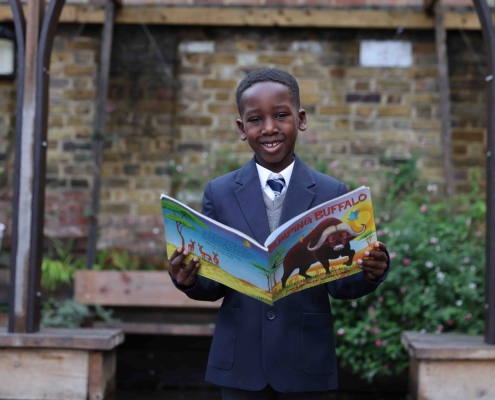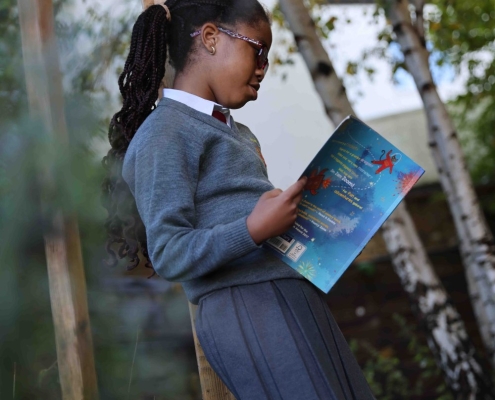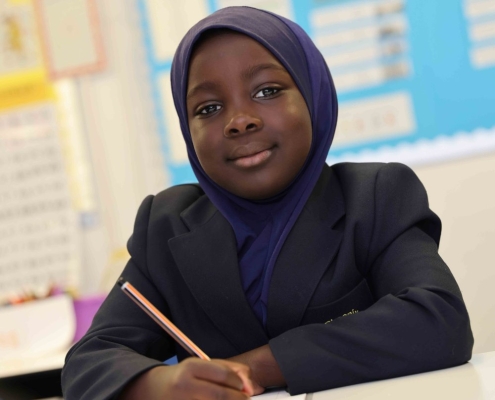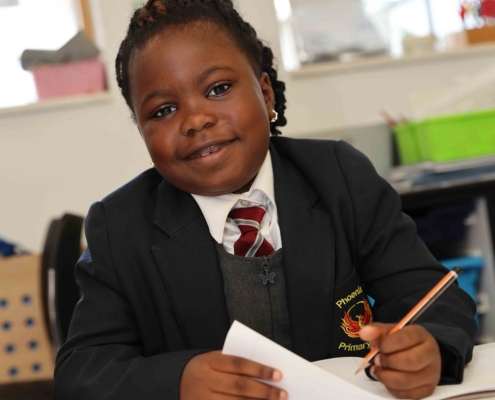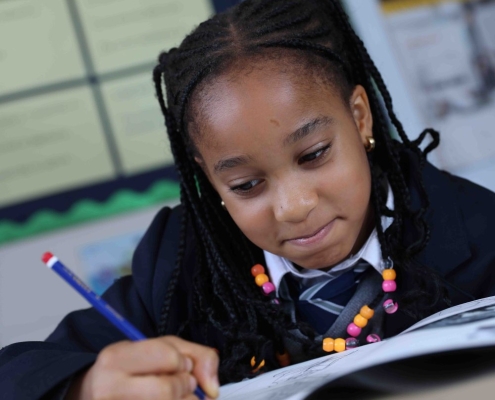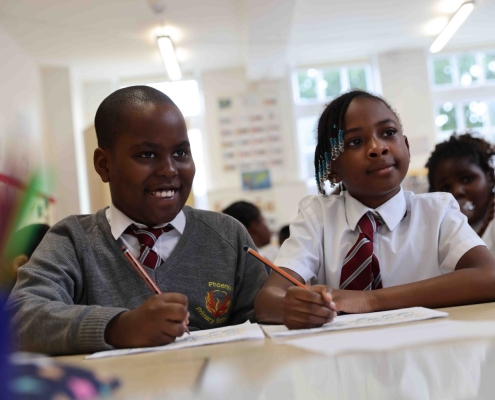Reading
Phonics
The school believes that a systematic and synthetic approach to phonics is essential in allowing every child to become and effective reader. From Nursery to Year 1, the children follow the Little Wandle Letters and Sounds Revised programme to ensure that progression across these year groups is rapid.
Daily phonics carpet sessions in Reception introduces four new sounds a week. In Year 1, children also learn four new sounds a week and alternative pronunciations of previously learned graphemes. Children are taught systematically and progressively in order to build a solid foundation of phonics before being introduced to a wider range of strategies in Year 2 and beyond. Teachers utilise the resources, including Big Cat reading scheme, which supports children’s learning to revisit, review, teach, practice and apply each sound as they progress through the scheme. All reading resources across Reception and Year 1 match to the stage of the children’s phonetical knowledge. Where this is not the case, children receive targeted intervention in order to ensure children keep on track.
Children have further opportunities to learn phonics through Daily Supported Phonics (DSPh) sessions. Within these sessions, children work in small groups with an adult and are given the chance to apply their phonetical knowledge to books that match what the children are learning in class, linked closely to their progress and stage of development in phonics. This targeted approach is put into place to ensure that all children are able to have a solid foundation in phonics by the end of Year 1.
Nursery- Foundations for Phonics
One of the most important aspects of Foundations for phonics is developing an awareness of sound, through activities that develop focused listening and attention,
including oral blending.
Reception
Year 1
Year 2 Daily Supported Reading (DSR)
Year 2: Daily Supported Reading (DSR)
Daily Supported Reading (DSR) is a quality first teaching programme that ensures sustained independent reading opportunities for all children in Year 2 who have successfully achieved and completed the phonics programme in Reception and Year 1. Each child in the programme receives a daily reading session at their instructional level, taught by a teacher or a trained adult.
A key principle that defines DSR is ensuring quality first teaching of reading for all pupils in Year 2. This approach to reading entails strategic deployment of adults from across the school to run DSR in small groups. The programme allows all children to have daily opportunities to read independently and in small groups, building upon their phonetical understanding through reading more complex reading books. Most importantly, children are able to read at an appropriate level and to a well-trained adult every day. This approach to early reading in Year 2 means that all children are able to make rapid progress. It also means that any child who is struggling can be identified and targeted in order to overcome any barriers.
The aims of DSR Programme are:
- To dramatically increase the quantity of texts that beginner readers engage with enjoyably and independently every day.
- To ensure that all children make good progress by working with a trained adult in small groups every day.
- To establish a coherent approach to early reading instruction in KS1.
- To increase the quantity and challenge of texts across the year that children access, whilst still enjoying daily independent reading in small groups.
- To enable children to learn to solve problems within texts independently, while keeping a story or message in mind.
The key features of the DSR programme:
- Quantity of Reading: Children read up to 70+ texts across a year, pitched to each child’s independent reading level.
- A Gradient of Difficulty: Adults learn to move children on. Lesson prompts/scripts change as texts get harder.
- Prompting: Children are required to monitor their reading and are prompted to notice errors and correct them independently.
- Comprehension: Lesson prompts/ Scripts link language that children use with that same language encoded in print. Children are taught to engage with and respond to text.#
Throughout Year 2, children continue to embed the mechanics of reading with focus on comprehension gradually increasing throughout the year.
KS2 Destination Reader (DR)
Destination Reader is an approach to teaching reading in Key Stage 2 that builds on children’s reading experience by focusing on comprehension. It involves daily sessions incorporating whole class modelling prior to the children applying these skills through partner and independent reading. Children deepen their understanding of the texts they read through the systematic use of a series of strategies and language stems. Children are exposed to the following reading comprehension strategies throughout the whole of Key Stage 2:
- Summarising
- Predicting
- Inferring
- Questioning
- Clarifying
- Making Connections
- Evaluating
Children are expected to apply these comprehension strategies through focused lessons. In addition, children are given regular opportunities to apply the use of strategies in lessons, where children are provided the opportunity to apply the strategies in a new context more independently. The approach encompasses the key principles of effective reading provision and fully meets the requirements of the National Curriculum. It also builds a culture of reading for pleasure and purpose. Destination Reader dramatically improves children’s reading, whilst making sure no one child is left behind. By developing a deeper understanding of what’s being read, Destination Reader actively engenders a love of reading which will endure throughout your children’s lives. In the few instances where children need additional support in their reading, targeted intervention revisiting phonics from early reading are planned and delivered.
Destination Reader helps staff improve their effectiveness in the teaching of reading through the use of proven techniques. The programme draws on existing practice and research. An approach rather than a scheme, Destination Reader fits right in with the wider curriculum and favourite texts.
Great thought has been put into compiling a comprehensive reading list for each year group, from Year 2 to Year 6. To see the books children will study, please click here.
Home Reading Books
- EYFS and Year 1:
Children within these Key Stages are provided with two reading books to support their reading development. One book is matched carefully to the child’s ability that matches the phonics that the child is being taught in school in line with the phase from the Little Wandle Letters and Sounds programme. The second book, which is to be shared with an adult at home, enables children to start to gain an understanding of comprehension, vocabulary, including rhyme and poetry, book structures and story-telling. This book will enable to the children to explore richer language and whole stories of a variety of publishers, prints and themes. This second book is chosen by the child, allowing for the child to have choice and a sense of agency, facilitating a stronger sense of reading for pleasure.
- Year 2 and Above:
Children who have successfully completed the phonics programme and are confident in all the phases of Letters and Sounds, are provided with a book banded book that is determined an appropriate instructional level by their teacher. Children will also have the chance to select an additional book that will continue to build up their vocabulary appropriately from a range of reading books from a variety of authors and publishers with themes suitable for their age groups. This second book is selected from a broader range of literature and is to be shared with an adult at home, until the child is fully confident in reading the book themselves.
Children who need additional support in remembering the phonemes will be provided with teaching and home reading books that suit their level of development. As children progress through Key Stage 2, it is an expectation that the books children are being asked to take home will develop in complexity of vocabulary, narrative structures, widening non-fiction genres and maturing themes and concepts. By the end of Year 6, we expect children to have read widely across a range of genres and authors, being able to discuss and explain their choices for the books they read. Home reading books are also matched to the topics that the children are learning in school, in order to support the development of knowledge across the curriculum.
Writing
EYFS
The EYFS Curriculum is progressive, starting with vocabulary linked to the children themselves, their immediate family and personal experiences. Throughout Nursery and into Reception, the topics promote a range of different language and experience. The children have access to a stimulating environment which offers a range of activities that inspire children’s interest and curiosity both indoors and outdoors. Learning occurs through first-hand experiences that encourage exploration, experimentation, observation, problem solving, prediction, critical thinking, decision making and discussion.
Each EYFS topic has an overarching prime area of learning focus. Vocabulary and facts that children learn are directly related to the theme. Units are structured around core texts, with the ‘Book of the Week’ at the heart of every activity. Through this, the children learn a vast variety of language and specific nuances of language from fiction, poetry and non-fiction texts. At the beginning of the week, there is a ‘hook’ to fully engage and interest the children; the children are then immersed in the text, through planned adult focus activities and independent enhanced provision within the indoor and outdoor environments. Planned adult directed activities include drama and talk to support understanding of the text and to develop vocabulary, language and ideas for writing. It is through this wonderful book-based curriculum that the children develop a love of reading.
Below you can find out more about the way that the EYFS curriculum prepares children for the National Curriculum in Key Stage One.
Key Stage 1 and Key Stage 2
The benefit of children working within a current topic means that they can gain knowledge and skills across a variety of subject areas in order to assist them in remembering new information gathered. Immersing the children within a topic also supports with children engaging in what they are learning. By generating a wide knowledge base of a particular topic, we believe children are supported in generating compositional ideas for writing outcomes. Therefore, the expectation for each topic is that the first section of the topic is using the foundation subjects to acquire a depth of knowledge and understanding. Once this has been established, a block of writing opportunities can be given to children in order to begin the writing process of drafting, editing, developing and publishing outcomes across a range of purposes, writing intentions and narrative genres.
Children are then expected to apply this understanding through being taught and given the opportunity to apply their understanding in two written outcomes – either fiction, non-fiction or poetry – in the last two weeks of the topic. By the time children have progressed through the school, they would have covered a full range of different genres, building on complexity in language, sentence types and overall compositional structures. Work completed in isolated Reading sessions and SPAG lessons are also applied and drawn upon to provide children the best chance to produce the best possible writing outcomes.
Writing outcomes for each year group can be seen here.
Spelling, Punctuation and Grammar
In order for every child to be proficient in literacy and language, we ensure that children are exposed to a range of Spelling, Punctuation and Grammar opportunities across the school. This is an overview of what the typical expectation for each Year group is to cover across and throughout the year, both embedded during writing sessions and also through discrete teaching opportunities in SPaG lessons.
| Punctuation | Grammar | |
| Year 1 | Capital letters for sentences
Capital letters for names and ‘I’ Exclamation marks Full stops Question marks |
Letters, words and sentences
Combining words into sentences Singular and plural Joining words and clauses using ‘and’ |
| Year 2 | Exclamation marks
Apostrophes for missing letters Apostrophes for possession Commas in a list |
Present and past progressive verbs
Nouns, adjectives, verbs and adverbs Forming compound nouns Co-ordinating conjunctions Subordinating conjunctions Noun phrases Statements/ Questions Commands/ Exclamations Tense agreement |
| Year 3 | Direct speech and inverted commas
Clauses and subordinate clauses Paragraphs –introduction Headings and sub-headings |
Present perfect form
Using ‘a’ or ‘an’ Conjunctions of time and cause Adverbs of time and place Prepositions Subordinating conjunctions |
| Year 4 | Paragraphing by theme
Direct speech and inverted commas Apostrophes for plural possession Commas after fronted adverbials |
Standard English verb forms
Noun phrases with adjectives/ prepositions Adverbials and fronted adverbials Good use of nouns and pronouns Determiners Pronouns and possessive pronouns |
| Year 5 | Parenthesis, brackets and dashes
Paragraph cohesion Commas to clarify meaning |
Relative pronouns and relative clauses
Linking ideas using adverbials Linking ideas using tense Ambiguity Adverbs of probability Modal verbs Verbs in perfect form Expanded noun phrases |
| Year 6 | Colons for independent clauses
Semi-colons for independent clauses Colons/ semi-colons for lists Paragraphs-linking ideas Bullet points Hyphens/ single dashes ellipses |
Formal and informal
Synonyms and antonyms Passive and active Subjunctive verb forms Subject-verb agreement Layout devices Subject and object |
The outline above is cumulative, whereby revisiting previous aspects of grammar throughout the year groups is expected practice. This enables children to build and develop confidence, as well as complexity of a range of SPaG devices throughout the SPaG curriculum in the school. In addition, this list is not exhaustive and aims to provide a general overview of the opportunity children should be exposed to as they progress through KS1 and KS2. We recognise that SPaG skills are a fundamental tool for children to become effective overall writers, and applying these skills in children’s independent writing is the overall aim. Furthermore, additional SPaG devices beyond this list are often taught to specific genres of writing that will further support the overall composition of effective writing. Therefore, we value the phonics work that is undertaken in KS1 and how this supports children’s ability to spell and is fully included within children’s learning journey within the school. Teachers also draw upon the established high frequency words to further ensure that children are able to become confident spellers by the time they leave our school.
Teachers plan daily short, sharp and succinct spelling, punctuation and grammar lessons and activities that give children the chance to use and apply a range of rules, with their exceptions, to a range of purposes and functions. In order to engage children in this area of the curriculum, lessons are planned with games and activities that we know Mayflower children enjoy, such as quizzes, sorting and matching and ‘quick-fire’ questions.
SPaG lessons across Key Stage 2 are derived from progressive medium term plans, which have direct impact on writing opportunities within the curriculum topic allocated for that year group in the term. Children are taught these SPaGs skills through a typical ‘Teach, Practice, Apply’ approach. This provides an opportunity for children to directly with the expectation that they will be applied in the writing workshops in the latter part of the topic.
Spelling
Spellings in KS2 are taught daily, building on the solid foundation of phonics developed in KS1. Each week, a new phoneme is explored and pupils are exposed to a range of graphemes that create this sound. Short, engaging activities are used to encourage the children to analyse and identify the graphemes, developing both reading and spelling confidence. Phonemes are repeated each year, ensuring that children built on their existing schema of a sound to incorporate new graphemes whilst also consolidating their understanding of previous years’ learning. As words contain multiple phonemes, a word will be taught several times across the course of the year, providing children with more exposures and thus greater opportunity for retention; for instance, the word ‘fortunate’ would be encountered whilst learning the ‘-or-‘, ‘-t-‘ and ‘-ay-‘ phonemes. At the end of each week’s learning, pupils are asked to write five sentences, as dictated by the teacher, to demonstrate their spelling of words in context.
Handwriting
At Mayflower Federation, we are committed to ensuring that all children achieve the highest standards in all areas of the curriculum, including handwriting. Our aim for children’s handwriting from Nursery to Year 6 is to prepare them for the demands of secondary school and beyond. To achieve this, we ensure all children develop a confident and efficient handwriting style that fully supports them with their learning. Children are taught the Nelson Handwriting Scheme across their time at our school. All classrooms display the lower case and upper case letters to model to children how to represent each letter.
Handwriting is a movement skill and needs to be developed throughout a child’s schooling. We regularly teach children to form letters with the correct sequence of stokes, vital to producing confident and fluent writers. Fluent handwriting is key to children accessing higher level learning for a number of reasons:
- It allows pupils to engage in quick note-taking.
- It creates confident and efficient handwriting is essential for essay writing and other demands.
- The more automatic the handwriting, the more children are able to focus on content.
Early Years:
In Nursery and the beginning of Reception, pre-writing / motor skills activities should be taking place daily. After practising pre-written shapes, children learn how to write their name and move onto phonics/ letter formation. Children are taught and regularly practise pre-writing shapes. Handwriting is taught through focus group work where pupils begin to learn single letter formation.
In order to prepare children to write, gross and fine motor skills are important when developing good pre-writing skills. Children are encouraged to take part in large movement activities as well as fine motor activities.
In this stage of learning, children are encouraged to develop the correct pen grip and to pick up the pen/ pencil near the point with thumb and index finger and swing the pen back into pen grip position.
Key Stage 1 Expectations:
Pupils’ writing during will generally develop at a slower pace than their reading. This is because they need to encode the sounds they hear in words (spelling skills), develop the physical skill needed for handwriting, and learn how to organise their ideas in writing. In writing, pupils should be able to form individual letters correctly, so establishing good handwriting habits from the beginning to support the move to joining is essential.
Key Stage 2 Expectations:
Joined handwriting should be the norm; pupils should be able to use it fast enough to keep pace with what they want to say. Pupils should be able to write down their ideas quickly. By the end of Year 6, pupils’ reading and writing should be sufficiently fluent and effortless for them to manage the general demands of the curriculum in Year 7.
